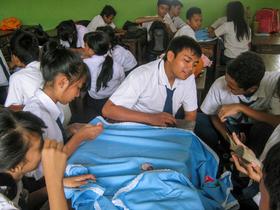Top Rankings
Faribault Public School District ranks among the top 20% of public school district in Minnesota for:
Category
Attribute
Diversity
Most diverse schools (Top 1%)
Community Size
Largest student body (number of students) (Top 1%)
For the 2025-26 school year, there are 6 public elementary schools serving 1,882 students in Faribault Public School District. This district's average elementary testing ranking is 2/10, which is in the bottom 50% of public elementary schools in Minnesota.
Public Elementary Schools in Faribault Public School District have an average math proficiency score of 19% (versus the Minnesota public elementary school average of 47%), and reading proficiency score of 33% (versus the 51% statewide average).
Minority enrollment is 70% of the student body (majority Hispanic), which is more than the Minnesota public elementary school average of 40% (majority Black and Hispanic).
Overview
This School District
This State (MN)
# Schools
11 Schools
1,651 Schools
# Students
3,014 Students
571,914 Students
# Teachers
234 Teachers
40,361 Teachers
Student-Teacher Ratio
13:1
13:1
Student By Grade
District Rank
Faribault Public School District, which is ranked within the bottom 50% of all 520 school districts in Minnesota (based off of combined math and reading proficiency testing data) for the 2022-2023 school year.
The school district's graduation rate of 77% has increased from 68% over five school years.
Overall District Rank
#429 out of 525 school districts
(Bottom 50%)
(Bottom 50%)
Math Test Scores (% Proficient)
18%
46%
Reading/Language Arts Test Scores (% Proficient)
33%
51%
Science Test Scores (% Proficient)
24%
41%
Graduation Rate
77%
84%
Students by Ethnicity:
Diversity Score
0.71
0.61
% American Indian
n/a
2%
% Asian
2%
7%
% Hispanic
33%
12%
% Black
24%
12%
% White
36%
60%
% Hawaiian
n/a
n/a
% Two or more races
5%
7%
All Ethnic Groups
District Revenue and Spending
The revenue/student of $20,762 is higher than the state median of $17,860. The school district revenue/student has grown by 11% over four school years.
The school district's spending/student of $20,453 is higher than the state median of $18,585. The school district spending/student has grown by 11% over four school years.
Total Revenue
$63 MM
$15,547 MM
Spending
$62 MM
$16,179 MM
Revenue / Student
$20,762
$17,860
Spending / Student
$20,453
$18,585
Best Faribault Public School District Public Elementary Schools (2025-26)
School
(Math and Reading Proficiency)
(Math and Reading Proficiency)
Location
Quick Facts
Rank: #11.
Lincoln Elementary School
(Math: 27% | Reading: 40%)
Rank:
Rank:
3/
Bottom 50%10
510 Lincoln Ave Nw
Faribault, MN 55021
(507) 333-6600
Faribault, MN 55021
(507) 333-6600
Gr: K-5 | 423 students Student-teacher ratio: 11:1 Minority enrollment: 71%
Rank: #22.
Jefferson Elementary School
(Math: 20-24% | Reading: 34%)
Rank:
Rank:
2/
Bottom 50%10
922 Sw Home Place
Faribault, MN 55021
(507) 333-6500
Faribault, MN 55021
(507) 333-6500
Gr: PK-5 | 395 students Student-teacher ratio: 11:1 Minority enrollment: 79%
Rank: #33.
Roosevelt Elementary School
(Math: 20-24% | Reading: 30-34%)
Rank:
Rank:
2/
Bottom 50%10
925 Parshall St
Faribault, MN 55021
(507) 333-6700
Faribault, MN 55021
(507) 333-6700
Gr: PK-5 | 418 students Student-teacher ratio: 12:1 Minority enrollment: 68%
Rank: #44.
Falcons Online Academy-middle
(Math: ≤20% | Reading: ≤20%)
Rank:
Rank:
1/
Bottom 50%10
710 17th St Sw
Faribault, MN 55021
(507) 333-6000
Faribault, MN 55021
(507) 333-6000
Gr: 5-8 | 10 students Student-teacher ratio: 10:1 Minority enrollment: 40%
Rank: #55.
Faribault Middle School
(Math: 14% | Reading: 31%)
Rank:
Rank:
1/
Bottom 50%10
704 17th St Sw
Faribault, MN 55021
(507) 333-6300
Faribault, MN 55021
(507) 333-6300
Gr: 6-8 | 636 students Student-teacher ratio: 13:1 Minority enrollment: 65%
Rank: n/an/a
Faribault Day School Alc
Alternative School
2855 1st Ave Nw
Faribault, MN 55021
(507) 333-6187
Faribault, MN 55021
(507) 333-6187
Gr: 6-8
Recent Articles

Charter Schools vs Public Schools 2025: Key Differences & Trends
Explore updated 2025 insights comparing charter schools vs public schools, enrollment, academic outcomes, funding, and real-world examples for families and educators.

Are Public Schools Ready for the 21st Century? 2025 Update
Explore 2025 insights on whether public schools are ready for the 21st century, covering performance, technology, equity, funding, and future-ready learning.

Public School Open House & Enrollment Season Guide
A parent-focused guide to the public school open house and enrollment season, with expert questions, timelines, and decision tips.





